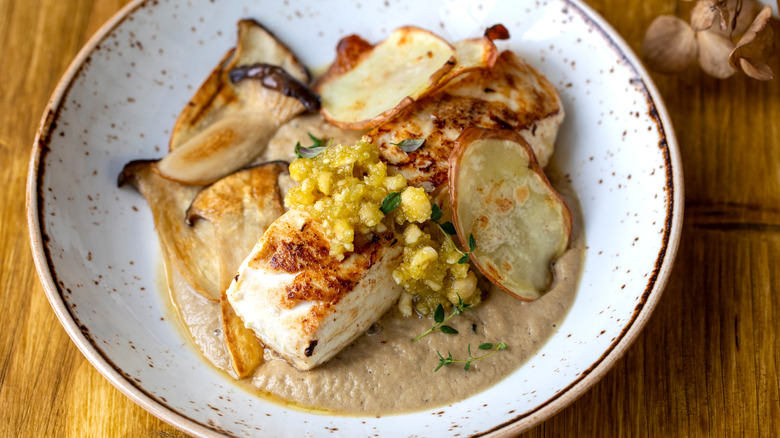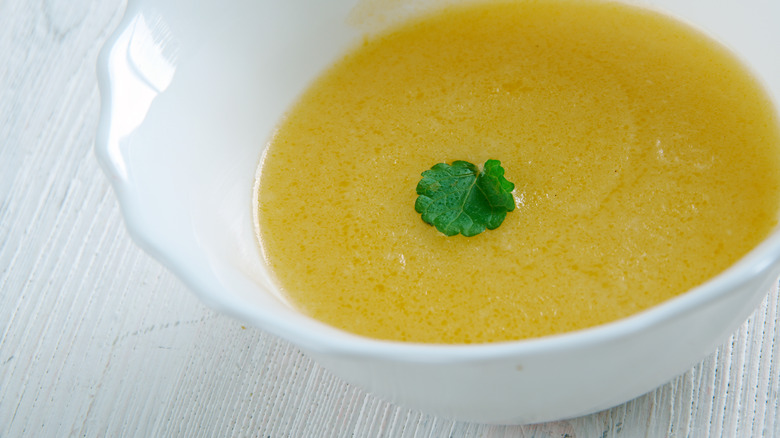How Are Velouté And Suprême Sauce Related?
If you've ever taken a cooking class, may it be professional or otherwise, the five mother sauces are undoubtedly part of the curriculum. But, inevitably, you might leave out one when asked to name them. The acronym BETH V. proves the most helpful in remembering all five — béchamel, espagnole, tomato, hollandaise, and velouté.
French chef Auguste Escoffier mapped out the five mothers' formulas in the 19th century as a starting point for most any sauce. Each consists of a liquid and thickening agent — three of which are thickened by a roux. If you like gumbo or enchiladas, for example, you know the velvety texture a roux can give to a dish.
Think of these sauces as the matriarchs of their families, whereas the sauces built from the mothers are called secondary sauces. With the addition of simple techniques such as deglazing the pan, reductions, and gastriques, you can expand the family tree.
In the case of suprême, which is the secondary sauce of velouté, consider it a branch of the mother sauce's family tree.
What is velouté?
Simply made from stock and a roux — velouté in its purest state is served as a gravy. In fact, it's a dry Thanksgiving turkey's saving grace. It's also the base for other dishes such as soups and stews. Its flavor can vary with the options of either chicken, fish, or veal stock. And, chefs will often finish the sauce with an acid such as lemon juice to brighten its palate. But, why stop there?
Like béchamel, velouté starts with a light roux made from flour and butter. Yet, its profile is deeper than a béchamel and isn't as thick while still lingering with a velvety mouthfeel. Velouté translates to mean velvet in French, after all. Even still, velouté takes a few queues from béchamel by utilizing cream for its daughters.
When using veal stock, the addition of egg yolks and cream transforms the mother into allemande sauce, while the fish-based velouté becomes a white wine sauce by incorporating white wine and heavy cream. And, for the most common velouté — which is chicken based — the simple addition of cream reigns supreme.
Suprême -- the daughter sauce
A staple in classic French cuisine, this daughter sauce shows up in recipes such as Julia Child's Suprêmes Volaille aux Champignons introduced in her 1961 "Mastering the Art of French Cooking". But, this isn't just a quick "bon appétit!" situation.
Upon mastering a silky velouté, reduce it with heavy cream or crème fraîche before straining for the more viscous suprême. Even hit it with another squeeze of lemon juice. Still, some chefs veer from tradition like Gordon Ramsay. He deglazes his pan with brandy — adding shallots, garlic, and herbs before the creme reduction.
A common shortcut to suprême is to thin out a béchamel sauce with stock. But, the chances of breaking the sauce are great and fixing the break might actually take longer than just starting from scratch.
But, whatever your choice of techniques, the sauce is imperative for the classic French dish Chicken Suprême. It's as simple as perfectly seared chicken breasts with the suprême sauce spooned over the top.
Following the progression of velouté to suprême — think of sauces such as ivory, mushroom, and aurora as velouté's grandchildren. So, the moral to this family's story is to start with a solid base — velouté — and work your way from there.


